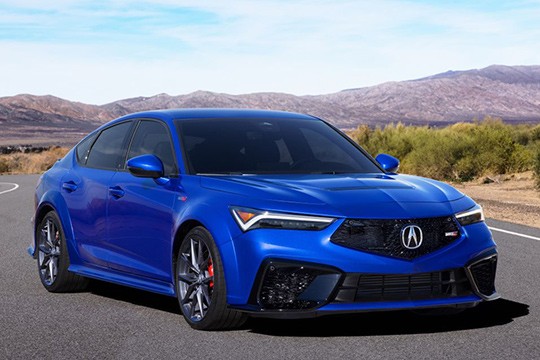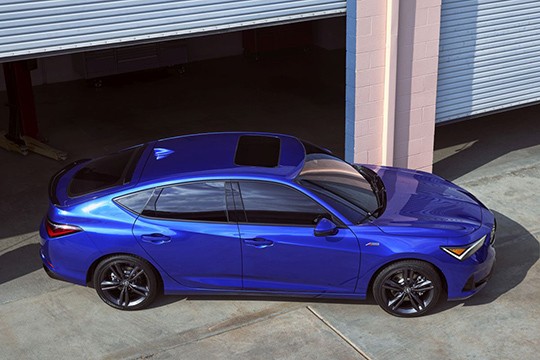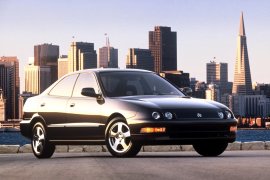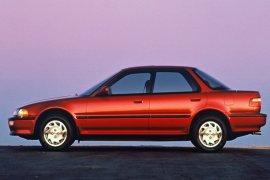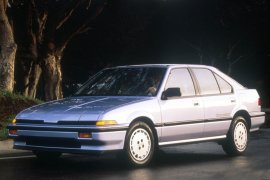ACURA Integra Sedan Models/Series Timeline, Specifications & Photos
First production year: 1986
Engines: Gasoline
The Integra Type S was already a well-known nameplate in the car-enthusiasts community, especially among Honda and Acura aficionados, and was revived in the mid-Spring of 2023.
Honda has used the Integra moniker on its own-badged products since 1985 on the Quint Integra model that was sold in Japan and later in the U.S. and Europe. But starting with the fourth generation, this nameplate was canceled from Acura's lineup, being replaced by the RSX. Come 2022, the premium Japanese brand brought it back and, in 2023, unveiled the Type S version that targeted the young generation. It was a sporty vehicle that could also provide enough comfort and space to be considered a family car.
Even though it wasn't the first four-door Integra, its sports-oriented designation was more obvious on the Type S version. The front fascia kept the angular styling from the rest of the Integra lineup but with a different bumper. That featured larger side scoops that flanked the apron fitted with a broad grille and a lip spoiler at the bottom. In addition, the main pentagonal grille was adorned with the Type S logo. Moreover, the hood was fitted with a vent. Finally, the automaker installed the three-exhaust system at the back, centrally mounted, like in the Civic Type R with which the Integra Type S shared its platform.
Inside, the automaker installed a similar-looking cabin as in the rest of the Integra, bar the six-speed manual that replaced the selector for the CVT. Moreover, the front seats' headrests were adorned with the TypeS badge embroidered.
But the most significant upgrade was on the drivetrain, which received the K20C turbocharged inline-four as the Civic Type R. It sent its power to the front wheels via a limited-slip differential. Unlike the Type R, which focused on performance, the Type S was designed mostly for street use, hence the adaptive suspension that allowed for a more comfortable ride than its Honda-labeled sibling.
When Acura revived the Integra in 2022, it made it available as a five-door hatchback, not as a coupe like its previous two generations.
While hard-core Acura fans remembered that once the Integra was produced either as a five-door liftback, a coupe, and a hard-top coupe, the fifth generation of this nameplate was introduced as a hatchback-only affair, and it was based on the same platform as the eleventh generation of the Honda Civic.
Sporting the new design language adopted by Acura for its entire lineup, the 2023 model-year Integra featured narrow LED headlights with signature DRLs inside. Its coupe-like shape was emphasized by the raked windshield and the sloped-down, curved roofline. Between the rear doors and the tailgate, the automaker installed a small triangular window, and finally, at the back, it featured slim taillights that combined curved lines with sharp angles.
Acura installed an upscale interior on the 2023 Integra, with bolstered front seats. On the dashboard, the carmaker added a standard 7" touchscreen for the infotainment system, with an option for a 9" one. Inside the instrument cluster, the carmaker placed a 12" TFT display. In the back, the Integra provided enough room for three adults, although the sloped roofline left little headroom.
The only engine option for the Integra Type A was a 1.5-liter turbocharged gasoline unit paired with either a six-speed manual or a CVT.
While most small-sized sedans were mostly econoboxes on wheels, the Integra was a different kind of vehicle. Despite its family-oriented body shape, it retained most of its coupe sibling features and performances.
The Integra was already known on the market and easy to recognize due to its four-round headlamps. Its front fascia featured an aggressive styling with a low nose and a sharp look enhanced with a large grille placed in the bumper, flanked by the corner-mounted turn signals. From its sides, the Integra sedan looked like a four-door coupe since it retained most of its two-door sibling styling. Its frameless doors and ascending beltline confirmed its sport-oriented behavior. At the back, the car featured the same wide, wrapped-around taillights split between the quarter panels and the trunk lid. Curiously, the carmaker didn't offer a lip-spoiler on the trunk, but that was available as a dealer option.
Inside, Acura made the same easy-to-reach and understand dashboard, with two large analog dials for the speedometer and tachometer, flanked by the coolant temperature and the fuel level gauges. Most of the trim levels were fitted with an AC unit and a stereo installed in the center stack. The front bucket seats were comfortable and featured adjustable lumbar control. In contrast, the folding bench in the back was suitable only for two short people or children.
Unlike many other vehicles on the market, the Integra sedan featured multilink independent suspension in all corners. Thanks to that, the car's handling matched the sporty look. Its 1.8-liter powerplant provided the highest specific power on the market. The GSR was only available with a five-speed manual. At the same time, the carmaker offered the base version with a four-speed automatic as well.
Acura introduced the second generation of the Integra in late 1989 as a 1990 model year, and it showed significant improvements over its predecessor.
When Honda launched the premium brand Acura, decided to build the cars with a completely different design than the Honda branded vehicles. It wasn't just a badge engineering with more features. It was almost a completely different car.
For the second generation, the Integra sedan dropped the pop-up headlights, which were mainstream in the '80s, but tend to disappear from the car fashion list in the '90s. The flat and low design concept gave the driver excellent visibility around the car due to its big and tall windows related to the vehicle's size. Its frameless side windows were not very common for that era.
Inside, the instrument cluster was similar to the one found in the Honda Accord. It was the same simple layout, but easy to read the most important data of the car. The flat dashboard design was not the most attractive feature, but it allowed great visibility to the road ahead. The short greenhouse was a problem for tall adults, but good for the average height ones.
Due to its new platform, with independent suspension in all corners, the Integra was often praised for its road holding in its class. Due to the new, 1.8-liter engine and the lightweight body, it could pull some good results on the acceleration, and it was very fuel-efficient as well.
Honda tried to upgrade its pace and introduced the Acura brand in 1986, and one of its first products was the Integra, which was sold as a hatchback or as a coupe.
Honda already knew how to build small-sized, good, reliable vehicles and understood that it could get a better margin from premium cars. That's why it made a decision to launch the Acura as a brand, but it played it safe by creating the Integra. Moreover, it was sold as a Honda or Rover on specific markets. Thus, if the brand wouldn't catch, it could still have profits from the other, better-known brands.
The Integra featured an unusual, bold styling with pop-up headlights. Yet, the five-door Integra dared to have that. To maximize the car's practicality, Honda made the car with a sloped tailgate, unlike the Civic, which featured either a regular hatchback or sedan shape. For the H-branded vehicles, Honda installed regular headlights but kept the sloped liftback in several markets sporting the Concerto nameplate.
Inside, the car showed a pair of low-mounted bucket seats at the front and a folding bench at the back. The angular styling was still a thing, so Honda installed a visor-like instrument cluster, where the clear layout showed a speedometer, a tachometer, and the fuel and temperature gauges. They shared the same area with a few warning lights. If in the U.S., the Acura offered the car with lots of amenities such as power windows and locks and AC, in Europe, it was rather poorly equipped.
Under the hood, Honda chose wisely and installed various gasoline engines, depending on the market. While in the U.S., it offered a fuel-injected inline-four, in Europe, it sold it with a four-carburetors setup, which was a mess to adjust and pricey at the pump.
